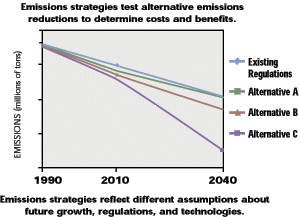SAMI's recommendations for
State action are scheduled for 2001.
Emission inventories, Phase I effects analyses, and
socioeconomic analyses are complete and available for other uses. SAMI participants have
access to modeling results as soon as they are completed. Atmospheric model results will
become available throughout the year 2000. Effects and socioeconomic components will not
be completed until early 2001.SAMI will
test alternative emissions management strategies.
SAMI is modeling regulations that implement the Clean
Air Act, both in the form they existed when SAMI began and in the form they are expected
to take when recent rules are implemented (i.e., regional nitrogen oxides reductions,
revised national ambient air quality standards, proposed regional haze rules). SAMI will
examine the significant improvements in air quality that will result from these current
regulations and will evaluate alternative strategies to meet the SAMI mission "to
remedy existing and prevent future adverse effects." Of the numerous possible
combinations of emissions reduction approaches, time and funding constrain SAMI to
modeling only a few strategies. The SAMI Policy Committee will select emission strategies
to be evaluated in the linked emissions, air quality, and effects models. From these
carefully selected strategies, state-of-the-art information on the environmental and
societal benefits and costs of these strategies will emerge. This information will then be
the basis for SAMI recommendations to member states

Analyses related to emerging state regulatory issues
are important SAMI products.
The SAMI model is ideally suited to address regional haze rules, and it may support
or even substitute for state modeling in some cases. SAMI modeling will also provide
insight to the transport of fine particles and their contribution to regional haze. Since
the SAMI atmospheric episodes were selected for relevance to Class I areas, ozone
attainment demonstrations in urban areas are probably not an appropriate use of SAMI
modeling. The states are currently developing their responses to the recent EPA
requirement for regional reductions in nitrogen oxides emissions to be included in state
air quality implementation plans. SAMI modeling will be useful to assess how the regional
nitrogen oxides reductions will affect the Class I areas. |
Regional cooperation is
essential to improve air quality in the Southern Appalachians. Air quality issues are too large for any one state or federal
agency to fully address alone. Pooling regional resources and influence will allow SAMI to
succeed in achieving its mission. SAMI has the potential to demonstrate an effective way
to sustain the environment while providing for economic growth in the Southern Appalachian
Mountains region. It establishes a model process for environmental decision making in the
1990s and beyond.
Because SAMI is a consensus-based, voluntary
organization, SAMI’s recommendations are likely to focus on incentives that prompt
regional, state, or community-based actions.
State regulatory agencies are active in SAMI and may promulgate regulations in
response to SAMI’s assessment results. Because SAMI operates by consensus, proposals
for major new regulations are unlikely to be a prominent part of SAMI’s Integrated
Assessment report to the states. As a forum that includes all stakeholders, SAMI’s
structure is ideal for developing incentive-based emissions reduction actions. SAMI will
consider a large number of possible recommendations for state action. Some of these are:
- changing fuels for vehicles and boilers,
- early adoption of new, cleaner technologies such as
coal gasification and energy efficient vehicles,
- accelerated development of promising technologies
such as fuel cells,
- cost-effective energy conservation measures,
- urban growth management for more efficient travel,
and
- incentives, such as tax benefits, to prompt earlier
adoption of cleaner technologies and compact growth.
SAMI participants will likely value the costs and
benefits of alternative emissions management strategies differently.
"How much protection is enough?" "How
much change to current lifestyles are we willing to accept and at what cost?" These
value questions underlie the difficult analyses that SAMI is pursuing. The value of the
natural resources and biological diversity of the Southern Appalachian Mountains is
difficult to express in economic terms. Additionally, the changes to current regional land
use, energy, and transportation patterns that may be required to reduce future emissions
are also difficult to predict. SAMI's assessment may not provide one right answer, but it
will assist in understanding the available choices to manage air quality in the future. |